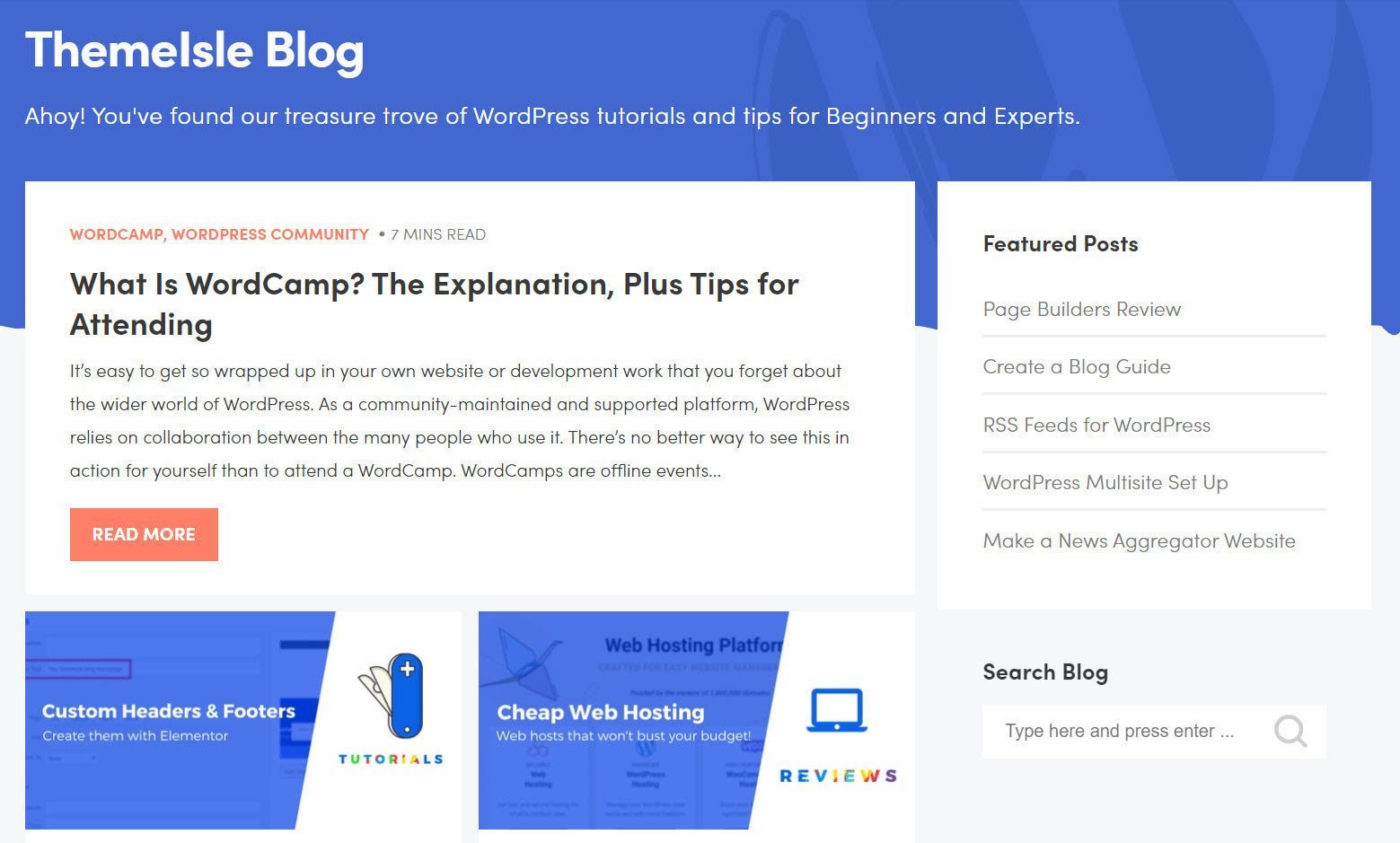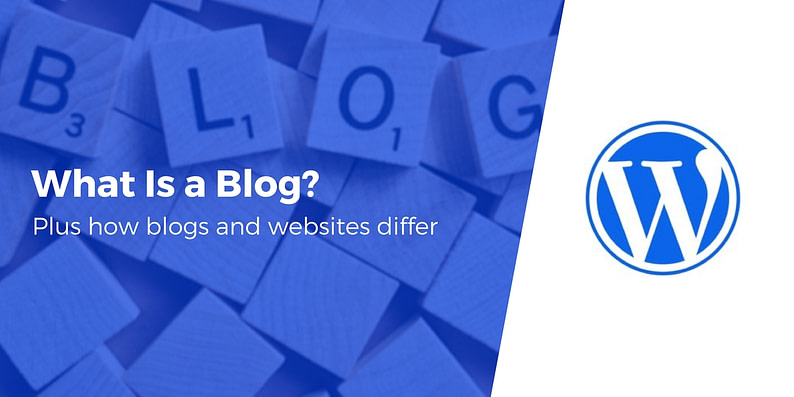What is a blog? In simplest terms, it’s a website where you’re regularly posting new content.
Often you will see the terms blog and website used interchangeably. However, a blog and a website are very different concepts and if you want to create a successful blog or website, or both, then you need to be clear what each entails. So exactly what is a blog, and how does it differ from a website?
In this article, we will define the concept of a blog, and that of a website. We will then look in depth at what a successful blog consists of, and provide plenty of top tips to help you start with your own lucrative blog.
What is a blog? Explained in more detail

First things first, a blog is a type of website. And a blog can also be part of a larger website. Confusing? Not at all!
A blog is much like an ongoing diary. It displays a collection of articles, written and published on a regular basis, and created for a particular audience with a purpose in mind.
So let’s take look at the identifiable features that make a blog specifically a blog…
- Reverse Chronological Content – Content is typically presented in reverse chronological order, with the most recent article displayed at the top of the page. Therefore, readers can quickly find the newest content addition.
- Dynamic Content – A blog’s content is regularly added to and updated. This ensures that blog visitors always have a range of new articles to browse.
- How Posts are Archived – Blog posts are usually archived by date, author, category, and tags.
- Comments Section – The majority of blogs display a comments section under each article. This is to help grow the blog’s community, encourage readers to discuss the post they have just read, and to help improve SEO.
As well as stand-alone blogs, many websites also boast a blog. This is because the presence of a blog can have numerous benefits – let’s find out more…
Why create a blog? What are the benefits?

Blogs were originally created by people to document their thoughts and share personal diary-type entries with their friends and family. However, over time this developed into thousands of niche style blogs that cover topics from health, food, travel, and lifestyle, to business, tech, and WordPress.
Here are just some of the benefits of creating a blog…
- Generate an Income
- Promote Products and Services
- Generate Leads
- Help You Become Known as an Expert in Your Field
- Drive Traffic to Your Website
- Improve SEO
- Get Your Thoughts and Opinions Heard
- Create a Community of Like Minded Individuals
Some blogs are run by individuals, but many are contributed to by numerous authors. Large businesses also run blogs on their websites to help them reach their target audience, keep their websites updated, and improve their rankings in the search engine.
So now we know exactly what a blog is, let’s compare a blog to a website…
What is the difference between blog and website?

The main difference between blog vs website is that a website’s content is mainly static. This means that content is published on a website and left for visitors to view, without generally being updated too often. To keep content fresh and varied, websites also often display a blog alongside their static content.
Website pages and content
It is hard to specify further on the definition of a website, as in the current online world websites come in all shapes and sizes. However, a business website, or a site promoting products and services, will generally have a number of prescribed pages. These include…
- Homepage – For grabbing users attention and signposting key content.
- About Page – Describing the website owner or business, who they are and what they stand for.
- Contact Page – Where contact formation is displayed, such as a contact form, email, physical address, telephone number, and more.
Other pages and features displayed on a website will very much depend on the niche or industry of the site. Let’s take a look at a few options…
- eCommerce Stores – Online stores usually contain numerous product pages as well as checkout and payment processes.
- Portfolio Sites – A portfolio website will display galleries of images and/or videos. Here professionals or artists can display their work at its best.
- Business Services – A business website promoting its services will usually include a portfolio of work as well as testimonials page from happy clients, an outline of the services offered, and sometimes a rundown of prices.
- Events and Listings – For websites advertising events, classes, or listings, you will often find pages devoted to timetables and relevant listings, as well as online booking features.
Although websites in the main contain static content, that is not to say that they aren’t kept updated. However, the important point to take away is that the main format of a website does not follow that of a blog. (i.e. the consistent publishing of articles and other dynamic content, displayed in reverse chronological order).
The features of a successful blog

Depending on your blog’s niche, its features may vary. However, there are some key features and tools that most blogs will want to incorporate.
- Headlines – Catchy and attention-grabbing headlines are crucial as they will entice your audience to read your articles.
- Content – However visually pleasing your blog is, if your content isn’t interesting and unique then your readers won’t return. Creating content that engages your audience should be your main priority.
- Article Layout – Use subheadings, short paragraphs, bullet points, and other literary techniques to help your audience easily skim-read your articles.
- Images – Using beautiful images will help to catch the eye of your readers, support your articles, and help inspire your audience.
- Author box – Adding an author bio box under each post helps readers connect with the authors. Use a WordPress plugin, like Simple Author Box, to add this functionality to your blog.
- Comments Section – WordPress provides a default comments section under blog posts, but using an advanced tool like Disqus will help further build a community around your blog.
- Related Posts – Displaying a related posts widget, like Related Posts for WordPress, will help encourage readers to click through to other posts on your blog.
- Social Media – Use Orbit Fox to promote your social media channels on your blog and encourage readers to share your content.
- Optin Forms – Grow your email list by adding optin forms to your blog.
As you can see, there is much you can do to improve your blog’s chances of success.
And if you are looking for a beautiful and professional WordPress blogging theme to get you started, check out Themeisle’s very own free Neve theme, a lightweight option that’s perfect for blogging.
Final thoughts on ‘what is a blog?’
For more in-depth information on how to create a blog, check out one or more of these guides…
- How to Start a WordPress Blog in 15 Minutes or Less
- Do You Have Your Blog Style Guide Yet? Here’s How to Create One
- How to Make Money Blogging – 17 of the Best Ideas
- 10 For-Beginners Hacks that Will Change the Way You Blog Forever
- When and How to Hire Freelance Writers to Boost Your Blogging Success
Still unsure about the difference between blog and website? Ask away in the comments section.





















Or start the conversation in our Facebook group for WordPress professionals. Find answers, share tips, and get help from other WordPress experts. Join now (it’s free)!